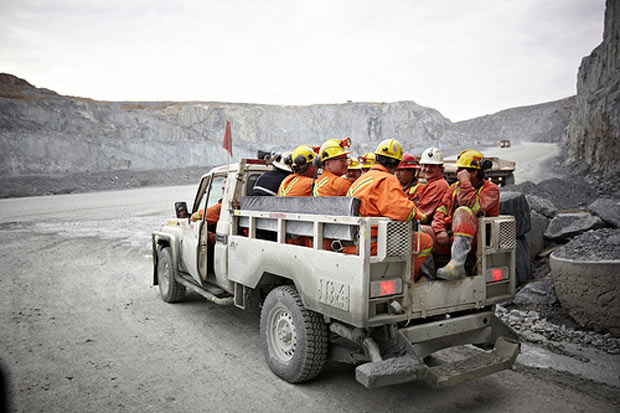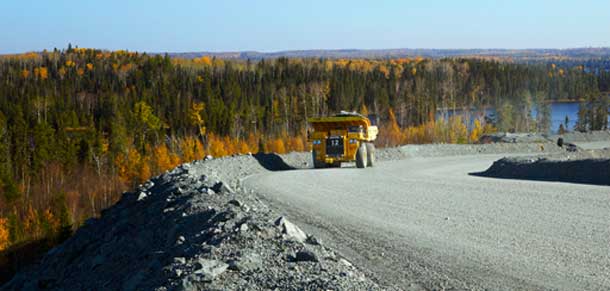 THUNDER BAY – It has been a good year for North American Palladium. “There is significant value to be unlocked at LDI, and I am encouraged by LDI’s future cash generation potential,” said Phil du Toit, President and Chief Executive Officer. “My initial review of operations reaffirmed the potential that I saw when I accepted the role as CEO, but also identified some challenges as well as opportunities for improvement in areas such as strategic mine planning, cost optimization and project execution”.
THUNDER BAY – It has been a good year for North American Palladium. “There is significant value to be unlocked at LDI, and I am encouraged by LDI’s future cash generation potential,” said Phil du Toit, President and Chief Executive Officer. “My initial review of operations reaffirmed the potential that I saw when I accepted the role as CEO, but also identified some challenges as well as opportunities for improvement in areas such as strategic mine planning, cost optimization and project execution”.
“This is a critical year for our transition and it will certainly not be without its challenges. We have a plan to unlock the high potential value of LDI, but this plan is contingent on a successful completion of a financing, therefore we are currently evaluating financing opportunities,” added du Toit.
North American Palladium
North American Palladium Ltd. announced the operating, development, and financial results for the first quarter ended March 31, 2013 for the company’s performance today.
Summary
- Produced 38,654 ounces of payable palladium at a cash cost per ounce(1) of US$490;
- Realized palladium selling price of US$730 per ounce, giving a palladium operating margin of US$240 per ounce, orUS$9.3 million;
- Revenue of $47.1 million;
- Adjusted EBITDA(1) of $7.5 million;
- Invested $38.1 million in capital expenditures at the Lac des Iles (“LDI”) mine, of which $31.7 million was invested in the LDI mine expansion; and
- 2013 operating and capital expenditure plans under review by new management.
Lac des Iles Operations
Q1, 2013 Production
In the first quarter of 2013, the Company’s LDI mine produced 38,654 ounces of payable palladium at a total cash cost of US$490per ounce(1).
During the first quarter, 540,694 tonnes of ore were mined at LDI, of which 245,656 tonnes came from underground sources (with an average palladium grade of 4.1 grams per tonne), and 295,038 tonnes came from surface sources (with an average palladium grade of 2.4 grams per tonne). During the first quarter, the LDI mill processed 503,585 tonnes of ore at a combined average palladium mill head grade of 3.3 grams per tonne, at an 80.1% palladium recovery rate, and at a total cost of $57 per tonne milled.
In the first quarter, capital expenditures at LDI totaled $38.1 million, of which $31.7 million was spent on the LDI mine expansion (including: $10.4 million on shaft sinking and infrastructure to extend the shaft 225 metres to the 670-metre level; $4.3 million on level access and vertical development; $4.0 million on surface and underground construction; $2.5 million on procurement; $1.9 million on parts and maintenance; $1.3 million on capitalized exploration expenditures; $2.9 million on general and administration, indirects and equipment charge-backs; $2.3 million for capitalized interest, and $2.1 million for other development costs). The Company also spent an additional $6.4 million on capital, including $5.5 million for the tailings management facility (“TMF”).
2013 Forecast Review
At the end of the first quarter, the new Chief Executive Officer and the Chief Financial Officer embarked on a detailed review of the Company’s 2013 operating plan, as well as the life of mine plan for the Offset Zone. The review is expected to be completed by the end of the second quarter, however preliminary findings identified some negative trends in operations and capital expenditures that are currently being assessed.
The logistics of the transition between the Roby Zone and the Offset Zone are proving to be more complicated than previously anticipated, which has resulted in a delay in stope development and a corresponding decrease in volume from the Offset Zone in 2013. Though the stope sequencing delay will result in reduced production from the Offset Zone in 2013, the long term benefit is that the Offset Zone can be mined more economically via the shaft in 2014.
Management believes that the low end of the 150,000 to 160,000 ounce production guidance will be difficult to achieve, and could potentially decrease by about 10% to 15%. As a result of decreased underground production levels and lower head grade of mill feed, cash costs are expected to increase. These estimates are indicative only, remain subject to the ongoing review of the mine plan and are contingent on the successful completion of a financing.
To compensate for the expected decreased production from the Offset Zone, the Company is actively pursuing additional mineralized material from other sources on the property, including the drilled off extensions of the Roby Zone and contributions from other surface sources (including stockpiles).
Recognizing that operating efficiency can only start to improve in a meaningful way once Phase II is completed, accelerating the shaft sinking beyond the Phase I 825-metre level will be the primary focus of the 2013 development plan review currently underway. As part of the ongoing reviews, the Company is also considering alternative bulk mining methods for the Offset Zone to further optimize mining volumes and production costs.
The preliminary project review has also indicated that the required capital expenditures to complete development of Phase I of the shaft project have been underestimated. After a review of certain procurement items and development plans (including accelerating plans to commence Phase II of the shaft sinking in 2013), management expects that capital expenditures in 2013 could be up to 35% higher than the prior guidance of $105 million. This estimate is preliminary, and is contingent on a financing.
The Company continues to look for opportunities to optimize its operations and development, and is actively sourcing opportunities for augmenting expected production with additional sources of ore. The Company also plans to strengthen its project team by engaging a professional project management contractor to assist with Phase II capital estimates, and to help implement improved cost and schedule controls for development.
“Overall, despite some of the transitional challenges that we will experience this year, I remain very optimistic about our future prospects at LDI,” added Mr. du Toit. “The value creation from this point on will depend on our execution; therefore my focus over the next few months will be to ensure that the Company is prepared for the transition to shaft-based operations, and that our plans for Phase II fully optimize the asset.”
LDI Mine Expansion Development
The Company continues to make steady progress with its mine expansion development activities and remains well positioned to start utilizing the shaft for underground production by the end of the third quarter in 2013.
Recent highlights include:
- The shaft sinking is on schedule, recently reaching a depth of 695 metres below surface, representing 84% completion of the total 825 metres planned for the first phase of the shaft sinking.
- The production hoist is now operational, and the installation of the main skip dump is in progress.
- The first Offset Zone mining stope (where mining commenced in the fourth quarter of 2012) has been successfully mined out, and production commenced in the second Offset Zone stope. The development of additional mining stopes experienced some delays, but is in progress.
- The ramp extension reached the 825-metre level depth and the shaft station there has been excavated and is being prepared for the shaft.
Financial Results (2)
Revenue for the first quarter was $47.1 million compared to $41.6 million in the first quarter of 2012. The increase in revenue was primarily due to greater quantities of payable metals sold, more favourable exchange rates and higher realized prices for palladium. Income from mining operations was $5.1 million, compared to $7.9 million in the same quarter last year. During the first quarter, the Company realized a palladium selling price of US$730 per ounce.
Net loss for the quarter was $2.8 million or $0.02 per share compared to a net loss of $0.9 million or $0.01 per share in the same quarter last year. Adjusted net loss(1) (which excludes exploration costs, gains and losses from discontinued operations, and insurance recoveries net of mine restoration costs) was $0.8 million in the first quarter, compared to adjusted net income(1) of$3.3 million in the same quarter last year.
EBITDA(1) was $2.9 million for the first quarter, compared to $5.0 million in the same quarter last year. Adjusted EBITDA(1) (which excludes interest and other financing costs, depreciation and amortization, exploration, and insurance recoveries net of mine restoration costs) was $7.5 million in the first quarter, compared to $8.2 million in first quarter last year.
In the first quarter, NAP invested $6.1 million in exploration and infill drilling, of which $1.3 million was capitalized in connection with the LDI mine expansion. Capital expenditures in the first quarter amounted to $38.1 million, of which $31.7 million was invested in the LDI mine expansion (including $2.3 million on capitalized interest) and an additional $6.4 million spent primarily on the tailings management facility. The Company’s general and administration expenses for the quarter ended March 31, 2013were $2.9 million.
As at March 31, 2013, the Company had $23.5 million cash on hand (which includes the proceeds from the sale of the gold division), and $1.2 million in working capital.
Recognizing that the anticipated operating cash flows are not expected to provide sufficient cash to fund capital expenditures planned for 2013, the Company is currently in the process of evaluating financing opportunities and plans to access the debt and/or equity markets in the second quarter. While the Company believes that both the debt and equity markets are currently available to finance its funding requirement, certainty of completing a financing cannot be assumed at this time, and if sufficient financing is not obtained, it will have a materially negative impact on the Company.
Corporate Update
The Company also announced that Mr. Greg Struble has resigned as Vice President and Chief Operating Officer, effective May 15, 2013, to pursue an opportunity as Chief Executive Officer with another public company in the industry.
“On behalf of the entire team at NAP, I would like to thank Greg for his commitment to the Company and important contributions throughout his tenure,” commented Mr. du Toit. “We wish him well with his new endeavor.”



